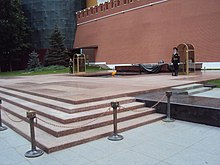
Tomb of the Unknown Soldier, Italy, under the statue of goddess Roma, at Altare della Patria, Rome. Above it can be seen the equestrian statue of Victor Emmanuel II of Savoy, the first king of a unified Italy
The Tomb of the Unknown Soldier refers to a monument dedicated to the services of an unknown soldier and to the common memories of all soldiers killed in war. Such tombs can be found in many nations and are usually high-profile national monuments. Throughout history, many soldiers have died in war with their remains being unidentified. Following World War I, a movement arose to commemorate these soldiers with a single tomb, containing the body of one such unidentified soldier.
History
France and the United Kingdom
During the First World War, the British and French armies who were allies during the war jointly decided to bury soldiers themselves. In the UK, under the Imperial War Graves Commission (now Commonwealth War Graves Commission), the Reverend David Railton had seen a grave marked by a rough cross while serving in the British Army as a chaplain on the Western Front, which bore the pencil-written legend "An Unknown British Soldier".[1]
He suggested (together with the French in their own country) the creation at a national level of a symbolic funeral and burial of an "Unknown Warrior", proposing that the grave should in the UK include a national monument in the form of what is usually, but not in this particular case, a headstone. The idea received the support of the Dean of Westminster, Prime Minister David Lloyd George, and later from King George V, responding to a wave of public support.[1] At the same time, a similar concern grew in France. In November 1916, a local officer of Le Souvenir français proposed the idea of burying "an unknown soldier" in the Panthéon. A formal bill was presented in Parliament in November 1918. The decision was voted into law on September 1919.[2]
The United Kingdom and France conducted services connected with their 'monumental' graves (as presumably newly conceived, and in any case approved, by their respective armies) on Armistice Day 1920 (the burial itself taking place later in January of the following year in France). In the UK, the Tomb of the Unknown Warrior was created at Westminster Abbey, while in France La tombe du soldat inconnu was placed in the Arc de Triomphe.
Other countries
The idea of a symbolic Tomb of the Unknown Soldier then spread to other countries. In 1921, the United States unveiled its own Tomb of the Unknown Soldier, Portugal its Túmulo do Soldado Desconhecido, and Italy its La tomba del Milite Ignoto. Other nations have followed the practice and created their own tombs.
In Chile and Ukraine, second 'unknown tombs' were unveiled to commemorate The Unknown Sailor.

